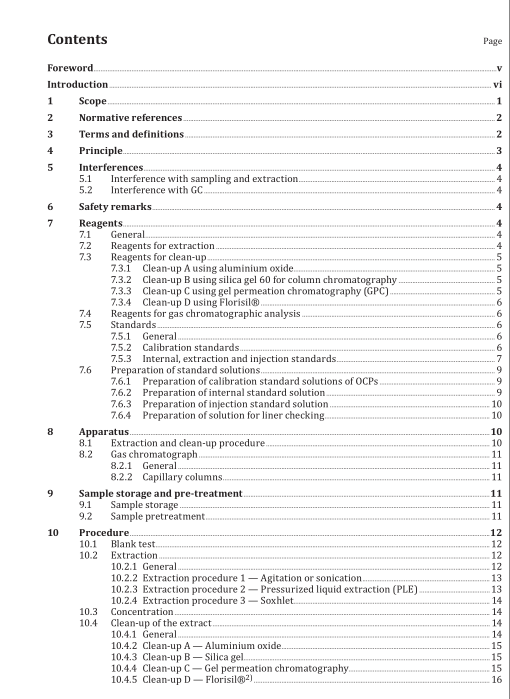ISO 23646:2022 pdf download.Soil quality — Determination of organochlorine pesticides by gas chromatography with mass selective detection (GC-MS) and gas chromatography with electron- capture detection (GC-ECD)
4 Principle
Due to the multi-matrix character of this document, different procedures for different steps (modules) are allowed. Which modules should be used depends on the sample. A recommendation is given in this document. Performance criteria are described and it is the responsibility of the laboratories applying this document to show that these criteria are met.
Use of spiking standards (internal standards) allows an overall check on the efficiency of a specific combination of modules for a specific sample. But it does not necessarily give the information regarding the extensive extraction efficiency of the native OCPs bonded to the matrix. After pre-treatment, the test sample is extracted with a suitable solvent or solvent-mixture. The extract is concentrated by evaporation.
If necessary, interfering compounds are removed by a clean-up method suitable for the specific matrix, before this concentration step.
The extract is analysed by gas chromatography. The compounds are separated using a capillary column with a stationary phase of low polarity. Detection takes place with mass spectrometry (MS) or with an electron capture detector (ECD). GC-MS/MS is also applicable if the described performance criteria (see 10.7.5) and performance characteristics (see Clause 11) are met.
OCPs are identified and quantified by comparison of relative retention times and relative peak heights (or peak areas) with respect to internal standards added. The efficiency of the procedure depends on the composition of the matrix that is investigated.
5 Interferences
5.1 Interference with sampling and extraction
Use sampling containers of materials (preferably of steel, aluminium or glass) that do not affect the sample during the contact time. Avoid plastics and organic materials during sampling, sample storage or extraction. Keep the samples away from direct sunlight and prolonged exposure to light.
During storage of the samples, losses of OCPs can occur due to adsorption on the walls of the containers.
The extent of the losses depends on the storage time.
5.2 Interference with GC
Substances that coelute with the target OCPs can interfere the determination. These interferences can lead to incompletely resolved signals and can, depending on their magnitude, affect accuracy and precision of the analytical results. Peak overlap does not allow an interpretation of the result.
Asymmetric peaks and peaks being broader than the corresponding peaks of the reference substance suggest interferences.
Depending on the utilized stationary phase, some isomers (e.g. 1,2,4,5- and 1,2,3,5-Tetrachlorobenzene) can coelute or be not fully separated. In this case, a positive result should be reported as the sum of both isomers or a different stationary phase should be applied to ensure a separation, which allows to give results for both single isomers.
6 Safety remarks
Some OCPs are toxic and shall be handled with extreme care. Avoid contact with solid materials, solvent extracts and solutions of standard OCPs. It is strongly advised that standard solutions are prepared centrally in suitably equipped laboratories or are purchased from suppliers specialized in their preparation.
Solvent solutions and samples containing OCPs shall be disposed of in a manner approved for disposal of toxic wastes.
For the handling of hexane, precautions shall be taken because of its neurotoxic properties.
Precautions shall be taken with respect to all hazards associated with this method.
7 Reagents
7.1 General
All reagents shall be of recognized analytical grade. The purity of the reagents used shall be checked by running a blank determination as described in 10.1. The blank shall be less than 50 % of the lowest reporting limit.
7.2 Reagents for extraction
7.2.1 Acetone (2-propanone), (CH 3 ) 2 CO.
7.2.2 n-heptane, C 7 H 16
7.2.3 Petroleum ether, boiling range 40 °C to 60 °C.
7.2.4 Hexane-like solvents, boiling range between 30 °C and 89 °C.
7.2.5 Anhydrous sodium sulfate, Na 2 SO 4 . The anhydrous sodium sulfate shall be kept carefully sealed.
7.2.6 Distilled water or water of equivalent quality, H 2 O.ISO 23646 pdf download.ISO 23646 pdf download
